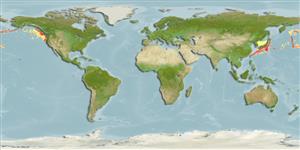分類 / Names
俗名 | 同種異名 | Catalog of Fishes(屬, 種) | ITIS | CoL | WoRMS | Cloffa
Teleostei >
Lophiiformes (Anglerfishes)
鮟鱇目 (Anglerfishes) >
Oneirodidae (Dreamers)
夢角鮟鱇科 (Dreamers)
Etymology: Bertella: After Erik Bertelsen (1912-1993) who served as curator of the 'Dana' collections at Danmarks Fiskeri-og Havundersøgelser, Charlottenlund, Denmark. (Ref.86949).
Eponymy: Dr Erik ‘Bertel’ Bertelsen (1912–1993) was a celebrated Danish fisheries biologist and ichthyologist at the Zoological Museum of the University of Copenhagen. [...] (Ref. 128868), visit book page.
Environment: milieu / climate zone / depth range / distribution range
生態學
海洋 深海底的; 深度上下限 805 - 3475 m (Ref. 58018). 溫帶; 55°N - 14°N (Ref. 123295)
Pacific Ocean.
北太平洋。
大小 / 重量 / 年齡
Maturity: Lm ? range ? - ? cm
Max length : 10.2 cm SL 雄魚/尚未辨別雌雄; (Ref. ); 8.4 cm SL (female); common length :559 cm TL (female)
簡短描述
檢索表 | 型態特徵 | 形態測量圖
背的軟條 (總數) : 5 - 6; 臀鰭軟條: 4 - 5. Metamorphosed females distinguished by the following characteristics: hyomandibular bone with single head; wide ethmoid cartilage and vomer, wider than distance between anterolateral tips of lateral ethmoids and frontals; presence of vomerine teeth in juvenile, lost with growth in adults; depressed ethmoid region, narrow and oval nasal foramina; frontals long and anterior in position, overhanging and extending past the anterior limits of the ethmoid cartilage and vomer; nearly linear dorsal margin of frontals; ventromedial extensions of the frontals approach each other on midline, making contact with parasphenoid; frontals separated from prootics; presence of pterosphenoid anterior end of illicial trough is wider and shallower than posterior end; well developed sphenotic spines; well developed symphysial spine on lower jaw; well developed quadrate spine; deeply notched posterior margin of opercle; long and narrow subopercle, dorsal end slender and tapering to a point, oval ventral end; absence of first pharyngobranchial; reduced and toothless second pharyngobranchial; second hypobranchial absent; caudal fin rays without internal pigmentation; illicium longer than length of esca bulb; pterygoiphore of illicium cylindrical throughout its length, emerging on snout from between frontal bones, anterior end slightly exposed, posterior end concealed beneath skin; well developed first ray of dorsal fin; dorsal fin rays 5-6; anal fin rays 4-5; short and broad pectoral fin lobe, shorter than longest rays of pectoral fin; pectoral fin rays 18-22; coracoid lacking posteroventral process; simple pelvic bones, with or without distal expansion; skin smooth and naked, without dermal spinules; darkly pigmented skin of caudal peduncle extends well past base of caudal fin (Ref. 86949).
Also caught with plankton nets.
也用浮游生物網捕獲。
Life cycle and mating behavior
成熟度 | 繁殖 | 產卵場 | 卵 | 孕卵數 | 仔魚
北太平洋。
Masuda, H., K. Amaoka, C. Araga, T. Uyeno and T. Yoshino, 1984. The fishes of the Japanese Archipelago. Vol. 1. Tokai University Press, Tokyo, Japan. 437 p. (text). (Ref. 559)
IUCN 瀕危狀態 (Ref. 130435: Version 2024-1)
無危 (LC) ; Date assessed: 11 October 2018
人類使用
漁業:
工具
特別的報告
下載 XML
網路資源
Estimates based on models
Preferred temperature (Ref.
123201): 2.1 - 3, mean 2.4 °C (based on 30 cells).
Phylogenetic diversity index (Ref.
82804): PD
50 = 1.0000 [Uniqueness, from 0.5 = low to 2.0 = high].
Bayesian length-weight: a=0.01995 (0.00906 - 0.04395), b=3.01 (2.83 - 3.19), in cm total length, based on all LWR estimates for this body shape (Ref.
93245).
營養階層 (Ref.
69278): 3.7 ±0.5 se; based on size and trophs of closest relatives
回復力 (Ref.
120179): 高度, 族群倍增時間少於 15個月 (Preliminary K or Fecundity.).
Fishing Vulnerability (Ref.
59153): Low vulnerability (10 of 100).
